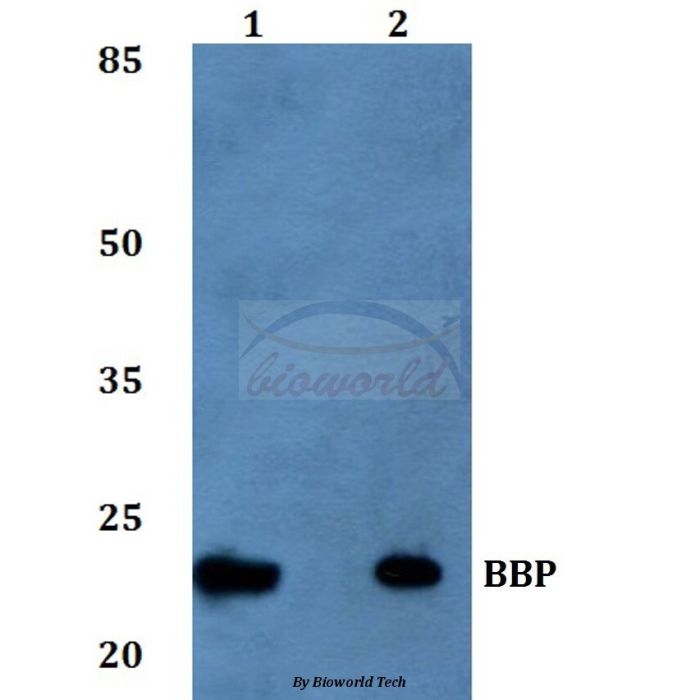BBP polyclonal, anti-human, mouse
€305.00
In stock
SKU
BS60257
Background:
Proteolytic cleavage of the Amyloid protein precursor (APP) gives rise to the β-Amyloid and Amyloid A4 proteins, which are present in human platelets. Amyloid deposition is associated with type II diabetes, Down syndrome and a variety of neurological disorders, including Alzheimer’s disease. Proteolytic cleavage of APP leads to the formation of the Amyloid β/A4 Amyloid protein. This protein is involved in the formation of neurofibrillary tangles and plaques that characterize the senile plaques of Alzheimer’s patients. BBP (Beta-amyloid-binding protein), also known as TM2D1 (TM2 domain-containing protein 1), is a 207 amino acid multi-pass membrane protein containing a G protein-coupling module that allows for interaction with the β-amyloid peptide of APP. In cell culture, expression of BBP induces caspase-dependent vulnerability to β-amyloid peptide toxicity, suggesting that it is a target of β-amyloid and may be involved in the molecular pathophysiology of Alzheimer’s disease.
Alternative Name:
TM2 domain-containing protein 1, Beta-amyloid-binding protein, hBBP, TM2D1, BBP
Application Dilution: WB: 1:500~1:1000
Specificity: BBP polyclonal antibody detects endogenous levels of BBP protein.
Immunogen:
A synthetic peptide corresponding to residues in Human BBP.
MW: ~ 22 kDa
Swis Prot.: Q9BX74
Purification & Purity:
The antibody was affinity-purified from rabbit antiserum by affinity-chromatography using epitope-specific immunogen and the purity is > 95% (by SDS-PAGE).
Format:
1mg/ml in PBS with 0.1% Sodium Azide, 50% Glycerol.
Storage:
Store at 4°C short term. Aliquot and store at -20°C long term. Avoid freeze-thaw cycles.
For research use only, not for use in diagnostic procedure.
Proteolytic cleavage of the Amyloid protein precursor (APP) gives rise to the β-Amyloid and Amyloid A4 proteins, which are present in human platelets. Amyloid deposition is associated with type II diabetes, Down syndrome and a variety of neurological disorders, including Alzheimer’s disease. Proteolytic cleavage of APP leads to the formation of the Amyloid β/A4 Amyloid protein. This protein is involved in the formation of neurofibrillary tangles and plaques that characterize the senile plaques of Alzheimer’s patients. BBP (Beta-amyloid-binding protein), also known as TM2D1 (TM2 domain-containing protein 1), is a 207 amino acid multi-pass membrane protein containing a G protein-coupling module that allows for interaction with the β-amyloid peptide of APP. In cell culture, expression of BBP induces caspase-dependent vulnerability to β-amyloid peptide toxicity, suggesting that it is a target of β-amyloid and may be involved in the molecular pathophysiology of Alzheimer’s disease.
Alternative Name:
TM2 domain-containing protein 1, Beta-amyloid-binding protein, hBBP, TM2D1, BBP
Application Dilution: WB: 1:500~1:1000
Specificity: BBP polyclonal antibody detects endogenous levels of BBP protein.
Immunogen:
A synthetic peptide corresponding to residues in Human BBP.
MW: ~ 22 kDa
Swis Prot.: Q9BX74
Purification & Purity:
The antibody was affinity-purified from rabbit antiserum by affinity-chromatography using epitope-specific immunogen and the purity is > 95% (by SDS-PAGE).
Format:
1mg/ml in PBS with 0.1% Sodium Azide, 50% Glycerol.
Storage:
Store at 4°C short term. Aliquot and store at -20°C long term. Avoid freeze-thaw cycles.
For research use only, not for use in diagnostic procedure.
| Is Featured? | No |
|---|
Write Your Own Review

